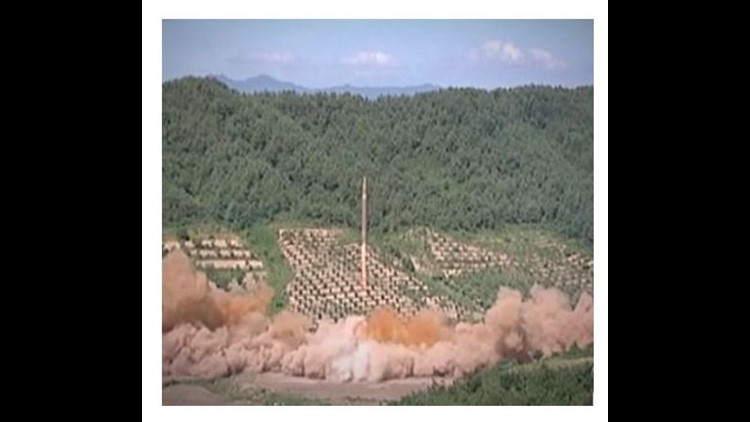TOKYO (CBS News) — Experts may debate trajectories, payload weights and re-entry shields, but North Korea‘s claim that the entire United States is within range of its rapidly improving missiles just got a lot more credible.
Wednesday’s launch of what the North called the Hwasong-15 intercontinental ballistic missile (ICBM) demonstrated a greater range than other missiles it’s tested and showcased several capabilities the North must master if it were ever to actually try to unleash them at the United States.
Here is a quick look at the advancements made, the developments still to come, and the implications for the United States and its Asian allies:
The missile itself
According to North Korea’s announcements about the launch, the Hwasong-15 can be tipped with a “super-large heavy warhead” and is capable of striking anywhere in the U.S. mainland. The North claims it reached an altitude of 2,780 miles and flew 600 miles from its launch site just outside of Pyongyang. It was airborne for 53 minutes before splashing down in the Sea of Japan.
The launch data jibe with what foreign experts observed. U.S. scientist David Wright, a physicist who closely tracks North Korea’s missile and nuclear programs, estimates the Hwasong-15 has an estimated range of more than 8,100 miles if flown on a standard trajectory — putting it within reach of Washington, D.C.
Pyongyang claims the missile has significant tactical and technical improvements from the Hwasong-14 ICBM it tested in July and is the North’s “most powerful” to date. KCNA also said Kim Jong Un “declared with pride that now we have finally realized the great historic cause of completing the state nuclear force.”
The repeated claim in the announcement that North Korea has now completed its “rocket weaponry system development” is new and important. It could be bluster, but might also suggest a shift away from tests — at least of these kinds of missiles — toward production and deployment.
The North’s arsenal is still a far cry from the quality and quantity of what the United States can field. The Air Force’s development of the Minuteman ICBM goes back to the late 1950s. It now has about 400 of the latest version, the Minuteman III, which also has a maximum range of about 13,000 kilometers.
How it was launched
The timing and location are important. It was launched in the dead of night, most likely from a mobile launcher, near the capital. That indicates the North was trying to show it can launch whenever and wherever it pleases — a capability makes it more difficult to take pre-emptive action. It’s impossible to blow up a North Korean missile on the launch pad if the missile can be moved and there isn’t any launch pad at all.
Interestingly, however, Japanese media reported on Tuesday their government had intercepted radio signals from the North suggesting a launch was imminent. It’s not clear if that was a first, since details on such intelligence are normally not made public. But it does suggest the North’s neighbors are having some success with surveillance efforts.
The trajectory of the launch is also significant. The missile was “lofted” at an extremely sharp angle and reached an altitude more than twice as high as satellites in low Earth orbit.
North Korea needs to launch toward the Pacific because it would otherwise be shooting its missiles at Russia or China — a very unwise proposition. And lofting avoids flying over Japan, which could prompt Tokyo or Japan-based U.S. missile-defense facilities to attempt an intercept, and hits open seas instead of other nations.
But lofting doesn’t closely simulate conditions of a real launch. Experts can roughly gauge the range of the missile from its lofted performance, but a missile on an attack trajectory would fly a lower, flatter pattern that presents some different challenges, particularly in the crucial re-entry stage of the nuclear payload.
So what now?
North Korea claimed as it always does that the test is part of its overall strategy to defend itself against Washington’s “nuclear blackmail” and that its development of missiles and nuclear weapons does not pose a threat to any country “as long as the interests of the DPRK are not infringed upon.” DPRK is short for North Korea’s official name, the Democratic People’s Republic of Korea.
In an equally familiar manner, the move was immediately condemned in the strongest terms by Tokyo and Seoul. President Donald Trump said Washington “will handle it,” while giving no indication of how or what handling it actually would mean.
A U.S. intelligence official told CBS News the U.S. was “not surprised” by the launch, and said there were plenty of recent “indications” of a possible launch.
The launch broke a two-month lull in what has been a record pace of tests for the North. While some claimed that was the result of pressure from the United States and its allies, it’s common for the North to re-focus its energies to farming activities during the harvest season and for its military to shift into a lower-profile mode for its winter training cycle.
North Korea still needs to conduct further missile tests, particularly of its submarine-launched missile systems, to improve its overall arsenal. But having now demonstrated what it claims to be the primary missile it needs to deter attack from the United States, Pyongyang may turn to more testing of its nuclear weapons.
So far, five of its six nuclear tests have been conducted in a series of tunnels under Mount Mantap, a 7,200 foot tall granite peak in the northeast part of the country. But Pyongyang has hinted it might attempt an atmospheric test over the Pacific Ocean.
That would be a far more provocative move than Wednesday’s missile test and might prompt a military response.



